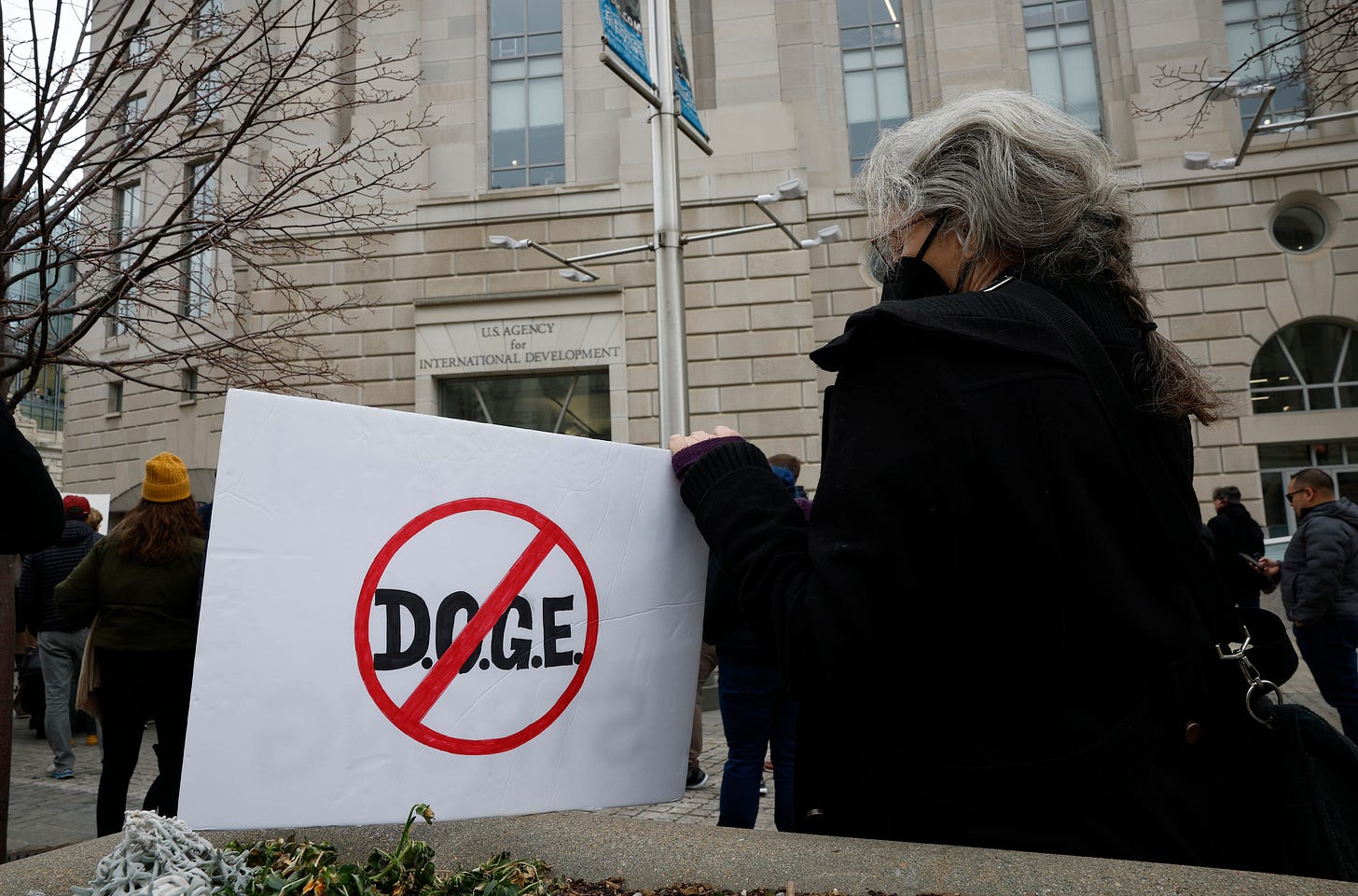Trump's DOGE War: The Secret Strategy That Could Change Everything
From a surface level, last week’s government funding fight had an obvious winner and an even more obvious loser.
Republicans exited the showdown united, with just one GOP lawmaker in each chamber of Congress opposing the stopgap bill to keep the government open. Meanwhile, the debate left Democrats sorely fractured, after Senate Minority Leader Chuck Schumer (D-NY) helped the bill advance despite the objections of House Minority Leader Hakeem Jeffries (D-NY) and a majority of his colleagues.
Days later, Democrats are still grappling with how to move forward from the fight.
But that retelling also glosses over a fair amount of fiscal uncertainty on the Republican side. After all, while most Democrats may have bitterly opposed the funding bill, it still largely maintained the $1.6 trillion federal budget set during the Biden years.
Many Republicans had pushed for cuts identified by Elon Musk’s Department of Government Efficiency (DOGE) to be included in the measure. They were overruled. Even if they held their noses and backed the package anyway, for Republicans who thought the Trump era would represent a new direction for congressional budgeting, the vote marked a disappointment.
“Why would I vote to continue the waste, fraud, and abuse DOGE has found?” Rep. Thomas Massie (R-KY), the lone House Republican to oppose the bill, wrote on X.
The dispute may have marked a clear political victory for Republicans, but as far as shrinking the federal budget goes, it was something of a substantive setback.
As Democrats more publicly lick their wounds, Republicans are now regrouping behind closed doors to figure out their next steps.
With the funding deadline behind them, how can they go about implementing DOGE cuts long term? The way I see it, they have three options to choose from, each with their own political or legal pitfalls.
The first option, of course, is to continue on their current path. Trump and Musk have already blazed a trail through government: firing thousands of government employees, halving the Education Department, hollowing out the U.S. Agency for
International Development (USAID) and the Consumer Financial Protection Bureau (CFPB), and — just last Friday — ordering an end to seven more agencies, including the federally funded broadcaster Voice of America.
They have neither sought nor received congressional approval to do any of that, which might suggest that they can simply continue chugging along just as they have.
The only problem: a lot of it hasn’t worked.
Nearly 25,000 federal workers have now been reinstated after a pair of federal judges ruled that Trump had failed to follow the law when conducting layoffs. (Then, when the administration simply placed most of the workers on administrative leave, one of the judges stepped in to say they couldn’t do that either.) The CFPB’s website once led to a 404 error message; now, the agency is again up and (partially) running, after a judge blocked the administration's attempts to close it.
On Tuesday, Trump and Musk suffered their latest legal setback when a judge ruled that the shutdown of USAID was likely unconstitutional. The judge ordered the administration to restore email access for USAID employees; he also said that Musk and DOGE could no longer be involved at the agency.
Ultimately, it will be up to the Supreme Court to decide the legality of these actions — but the (small) signs we have so far don’t point to a particularly sympathetic bench. The justices declined to side with the administration in early rulings in both of the cases that have reached the high court so far, including a dispute involving USAID.
If the Supremes follow the lead of lower court judges, they could end up telling Trump that he can only make his desired cuts with congressional support. “These actions harmed…the public interest,” the judge in the USAID case ruled Tuesday, “because they deprived the public’s elected representatives in Congress of their constitutional authority to decide whether, when, and how to close down an agency created by Congress.”
Luckily for Trump, there’s an option waiting for him if he wants to make the DOGE cuts actually stick, in a way judges can’t overturn. And not even Elon Musk knew about it until recently.
I’ve written here before about the Impoundment Control Act, a 1974 law that prevents the president from unilaterally declining to spend funds approved by Congress. The statute is mostly brought up as an obstacle for Trump — he stands accused of breaking it in several contexts — but it also contains a tool that could help him legally slash the federal budget.
The law allows the president to send to Congress something known as a “rescissions package,” basically a list of all the different line items in the federal budget he’d prefer not to spend. Lawmakers then have 45 days to consider the request. If (and only if) such a package is approved, the president can legally decline to spend appropriated funds.
The kicker is that — like the reconciliation process, which Republicans are using to advance other parts of the Trump agenda — a rescissions package can’t be filibustered in the Senate, which means the measure would only need 51 votes (instead of the usual 60) to advance. Trump could codify any DOGE cuts he wants purely with Republican votes.
As long as he keeps the party’s slim majorities united, that is. The most recent president to propose a rescissions package was Trump himself, who tried to make $15 billion in cuts in 2018. The package narrowly passed the House, with 19 Republicans dissenting (more than the GOP could afford with their current majority). But it failed to pass the Senate, partially due to opposition from Sen. Susan Collins (R-ME).
No president has successfully passed a rescissions package since Bill Clinton.
Trump has yet to submit a rescissions request in his second term, something that hasn’t escaped the notice of judges ruling on his spending decisions. “It is uncontested that [the administration has] not undertaken the procedures required for the impoundment of congressionally appropriated aid, whether permanent or temporary, by the Impoundment Control Act,” one judge wrote last week.
But there are signs that one could be coming: in a February meeting where Senate Republicans “vented their concerns”about DOGE directly to Musk, Sen. Rand Paul (R-KY) reportedly pitched the Trump adviser on a $500 billion rescissions package.
Multiple senators told NBC News that Musk was “surprised to learn there was a viable legislative pathway to making DOGE’s cuts permanent.” When he was told, Sen. Lindsey Graham (R-SC) said, Musk was “so happy” that he pumped his fists and danced. Vice President JD Vance told House Republicans last week that a rescissions package is on its way.
It is unclear which funds would be included in the bill. On its website, DOGE claims $115 billion in estimated savings, although its ledger is riddled with errors. In addition, some of the effort’s higher-profile actions aren’t so popular among Republican lawmakers, especially cuts that are in their districts. When Paul forced a vote on a measure to codify the USAID cuts last week, 26 Republicans voted against it, pointing to the difficulties to come.
That leaves Door No. 3, challenging the constitutionality of the Impoundment Control Act itself.
Trump and his allies have suggested in the past that the statute is an illegal breach of presidential power; per Fox News, the White House is currently “working on a strategy” to “impound” (or refuse to spend) federal dollars, which would force a direct fight over the ICA’s constitutionality.
“He’s got the constitutional right to [impound], so he’s going to push on with it, and thinks the courts will ultimately side with him,” Rep. Ralph Norman (R-SC) told Fox. “I can’t get in Trump’s mind, but I know he’s hell-bent on interpreting the Constitution as his right to use impoundment.”
Other Trump allies are less enthusiastic, creating a split between those who want Trump to spark a constitutional fight and those who hope he codifies the cuts in a by-the-book fashion. “My message to Elon was, let’s get over the impoundment idea and let’s send it back as a rescission,” Paul said earlier this month. To make the cuts “real,” he added, “to make it go beyond the moment of the day,” Congress would need to put its stamp on them.
“If we lose in court…we’re bound by it,” Graham said of challenging the ICA, explaining why he hoped the White House pursued a rescissions strategy instead.
Not known for shying away from multi-front battles, the Trump White House could also try to wage both efforts at once, attempting to push a rescissions package through Congress under the Impoundment Control Act, while simultaneously arguing in court that the law is unconstitutional.
The congressional option has no guarantee of political success; based on past precedent, the court option will likely be an uphill fight. But if Trump and Musk want to leave a lasting imprint on the federal budget, the fights over rescissions and impoundment will be the next legislative and legal battles to watch.









Great, there may be legal ways for Musk to continue his wasteful and wanton cruelty. But Gabe, some of your word choices leave a lot to be desired. “Trump and Musk have already blazed a trail through government …” makes them sound like Lewis and Clark when a more apt comparison is Genghis Khan teaming up with Attila the Hun to rampage and pillage throughout the land.
What's truly alarming about this entire DOGE situation isn't just the reckless cuts themselves, but how it's exposing and accelerating the erosion of constitutional guardrails. When senators like Graham and Paul are actively helping the executive branch find workarounds to congressional appropriations authority, we're witnessing an institutional failure. These senators are essentially conspiring to diminish the very legislative power they've been elected to exercise. The Constitution's framers would be stunned to see legislators eagerly helping a president circumvent Congress's most fundamental power.
This goes beyond partisan politics. What we're seeing is the culmination of decades of congressional abdication, where lawmakers from both parties have repeatedly surrendered their constitutional responsibilities to avoid difficult votes. The modern Congress increasingly prefers to delegate hard decisions to the executive branch, then criticize the results without having their fingerprints on the policy. The current Republican enthusiasm for rescissions or challenging the Impoundment Control Act is the logical endpoint of this long-term institutional decline, where legislators actively undermine their own constitutional authority for short-term political convenience.
If Trump and Musk succeed with either strategy, it will permanently alter our constitutional framework. Future presidents - Democratic or Republican - would inherit these expanded powers, and the precedent would be nearly impossible to reverse. (Though if we look at how Biden largely ignored the expansive presidential powers that the Supreme Court handed him during his final weeks in office, it seems as though maybe only one party has the political will to fully utilize these authorities.) The Supreme Court has historically been reluctant to robustly enforce separation of powers in fiscal matters, viewing them as primarily political questions. We're witnessing the quiet transformation of our system from one where Congress controls spending to one where the president enjoys discretionary impoundment authority that the Framers explicitly rejected.
And of course, I always have to mention irony. During the 2016 presidential campaign, Trump constantly criticized Obama's use of executive orders, stating that Obama "just goes along and signs executive orders for everything... because that's easy to do." He then proceeded to match and now exceed Obama's pace of executive orders during his own terms. His stance on executive authority has nothing to do with constitutional principles and everything to do with who holds the office. When he's not president, executive power is dangerous corruption; when he is president, it's unquestionably necessary.
We have to ensure our persuadable loved ones understand that this constitutional reshuffling isn't just procedural minutiae but a permanent restructuring of American governance. Legislators need to feel genuine constituent pressure regardless of whether they directly voted on specific cuts. Demand that budget deficits are paid for by the wealthiest who pay lower percentages of their income in taxes. Speak out against cuts to programs that support everyone who needs support. Supporting a president's agenda generally is still something we can hold them accountable for. When enough voices demand that Congress reassert its constitutional prerogatives, legislators will become more afraid of their constituents than of their party leadership. And when Trump’s polling numbers inevitably fall to their low-low-low baseline numbers, Rs will distance themselves like they did last time. This constitutional crisis is happening in plain sight, but without enough citizens recognizing it for what it is, the guardrails will continue to crumble with barely a whimper. Make sure your friends and family members in “conservative” districts are informed and making their voices heard.